Page 62 of 467

WARNING!Ignoring the AIRBAG light in your instrument panel
could mean you won't have the airbags to protect you
in a collision. If the light does not come on, stays on
after you start the vehicle, or if it comes on as you
drive, have the airbag system checked right away.
Impact Sensors
Two sensors, located on the front body structure, trigger
airbag deployment in direct frontal impacts and aid the
Occupant Restraint Controller (ORC) in determining
appropriate response to frontal impact events. Additional
sensors in the ORC determine the level of airbag deploy-
ment and provide deployment verification. Side Inflatable Curtain and Front Seat Mounted
Airbags Ð If equipped
The Occupant Restraint Controller System (ORC) de-
ploys the side inflatable curtain and seat mounted thorax
side airbags during collision with other vehicles and
during collisions where the impact is confined to a
particular area of the vehicle Ð such as collisions with
poles, trees or similar objects.
It will deploy the side inflatable curtains and front seat
thorax mounted airbags only on the impact side of the
vehicle.
The front driver and passenger seat contain inflatable
side airbags to protect the occupant from impact injuries.
Correctly functioning front passenger seat components
are critical for the Occupant Restraint Controller System60 THINGS TO KNOW BEFORE STARTING YOUR VEHICLE
Page 63 of 467
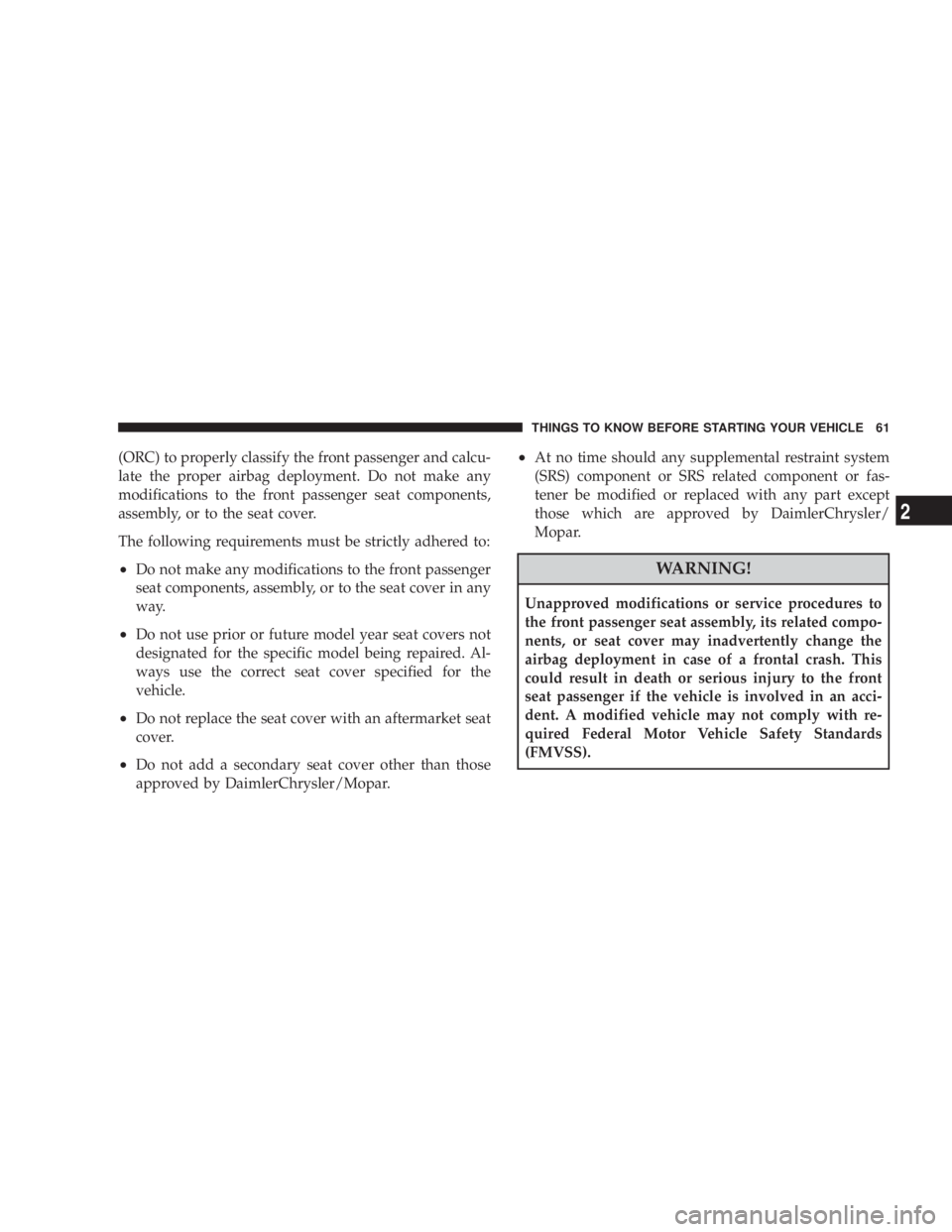
(ORC) to properly classify the front passenger and calcu-
late the proper airbag deployment. Do not make any
modifications to the front passenger seat components,
assembly, or to the seat cover.
The following requirements must be strictly adhered to:
² Do not make any modifications to the front passenger
seat components, assembly, or to the seat cover in any
way.
² Do not use prior or future model year seat covers not
designated for the specific model being repaired. Al-
ways use the correct seat cover specified for the
vehicle.
² Do not replace the seat cover with an aftermarket seat
cover.
² Do not add a secondary seat cover other than those
approved by DaimlerChrysler/Mopar. ² At no time should any supplemental restraint system
(SRS) component or SRS related component or fas-
tener be modified or replaced with any part except
those which are approved by DaimlerChrysler/
Mopar.
WARNING!Unapproved modifications or service procedures to
the front passenger seat assembly, its related compo-
nents, or seat cover may inadvertently change the
airbag deployment in case of a frontal crash. This
could result in death or serious injury to the front
seat passenger if the vehicle is involved in an acci-
dent. A modified vehicle may not comply with re-
quired Federal Motor Vehicle Safety Standards
(FMVSS). THINGS TO KNOW BEFORE STARTING YOUR VEHICLE 61
2
Page 65 of 467
process that generates the nontoxic gas used for airbag
inflation. These airborne particles may irritate the skin,
eyes, nose, or throat. If you have skin or eye irritation,
rinse the area with cool water. For nose or throat
irritation, move to fresh air. If the irritation continues,
see your doctor. If these particles settle on your
clothing, follow the garment manufacturer's instruc-
tions for cleaning.
² It is not advisable to drive your vehicle after the
airbags have deployed. If you are involved in another
collision, the airbags will not be in place to protect you. WARNING!Deployed airbags and seat belt pretensioners cannot
protect you in another collision. Have the airbags,
seat belt pretensioners, and the front passenger seat
belt retractor assembly, replaced by an authorized
dealer as soon as possible. Also, have the Occupant
Restraint Controller System serviced as well. THINGS TO KNOW BEFORE STARTING YOUR VEHICLE 63
2
Page 66 of 467
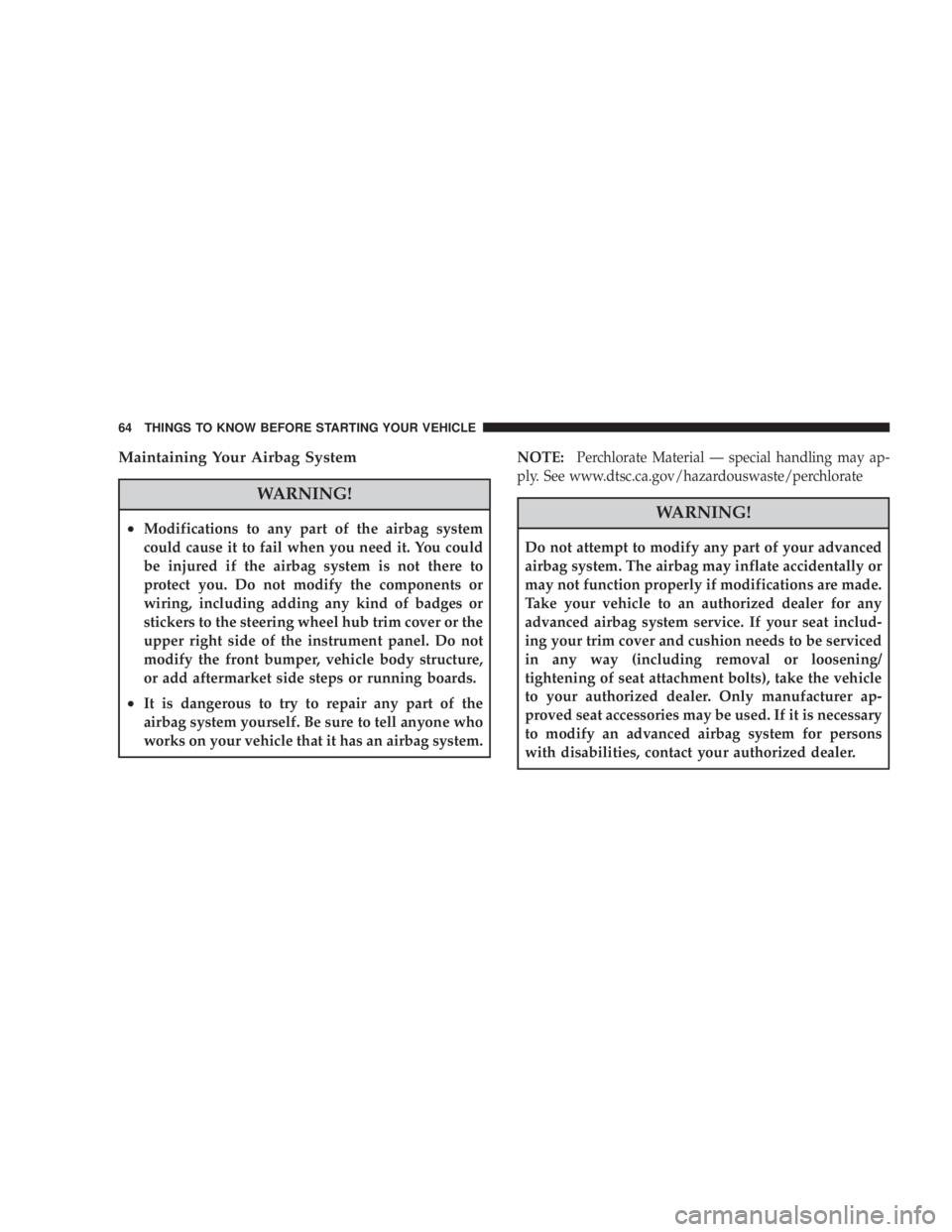
Maintaining Your Airbag System
WARNING!² Modifications to any part of the airbag system
could cause it to fail when you need it. You could
be injured if the airbag system is not there to
protect you. Do not modify the components or
wiring, including adding any kind of badges or
stickers to the steering wheel hub trim cover or the
upper right side of the instrument panel. Do not
modify the front bumper, vehicle body structure,
or add aftermarket side steps or running boards.
² It is dangerous to try to repair any part of the
airbag system yourself. Be sure to tell anyone who
works on your vehicle that it has an airbag system. NOTE:
Perchlorate Material Ð special handling may ap-
ply. See www.dtsc.ca.gov/hazardouswaste/perchlorate
WARNING!Do not attempt to modify any part of your advanced
airbag system. The airbag may inflate accidentally or
may not function properly if modifications are made.
Take your vehicle to an authorized dealer for any
advanced airbag system service. If your seat includ-
ing your trim cover and cushion needs to be serviced
in any way (including removal or loosening/
tightening of seat attachment bolts), take the vehicle
to your authorized dealer. Only manufacturer ap-
proved seat accessories may be used. If it is necessary
to modify an advanced airbag system for persons
with disabilities, contact your authorized dealer.64 THINGS TO KNOW BEFORE STARTING YOUR VEHICLE
Page 69 of 467
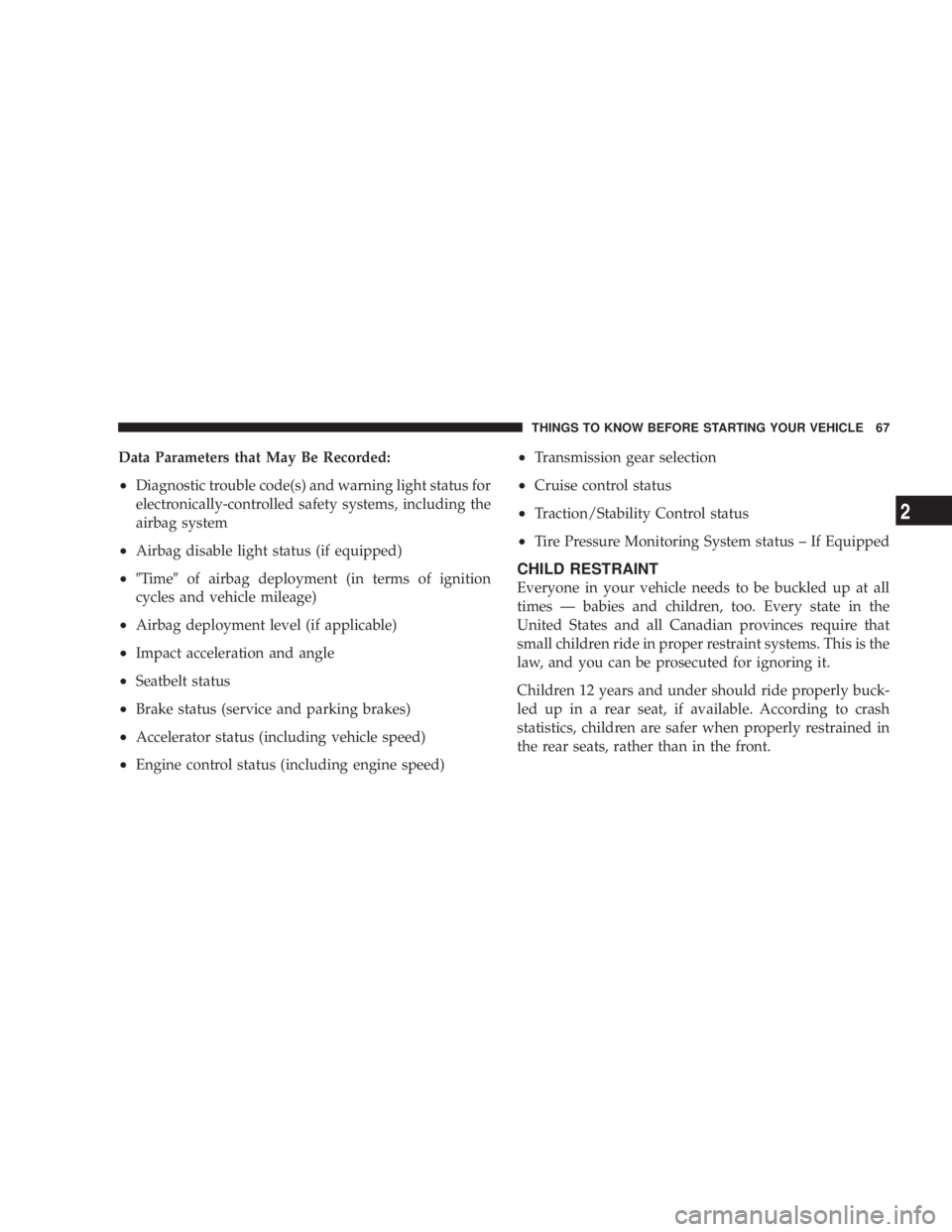
Data Parameters that May Be Recorded:
² Diagnostic trouble code(s) and warning light status for
electronically-controlled safety systems, including the
airbag system
² Airbag disable light status (if equipped)
² 9 Time 9 of airbag deployment (in terms of ignition
cycles and vehicle mileage)
² Airbag deployment level (if applicable)
² Impact acceleration and angle
² Seatbelt status
² Brake status (service and parking brakes)
² Accelerator status (including vehicle speed)
² Engine control status (including engine speed) ² Transmission gear selection
² Cruise control status
² Traction/Stability Control status
² Tire Pressure Monitoring System status ± If Equipped
CHILD RESTRAINT
Everyone in your vehicle needs to be buckled up at all
times Ð babies and children, too. Every state in the
United States and all Canadian provinces require that
small children ride in proper restraint systems. This is the
law, and you can be prosecuted for ignoring it.
Children 12 years and under should ride properly buck-
led up in a rear seat, if available. According to crash
statistics, children are safer when properly restrained in
the rear seats, rather than in the front. THINGS TO KNOW BEFORE STARTING YOUR VEHICLE 67
2
Page 70 of 467
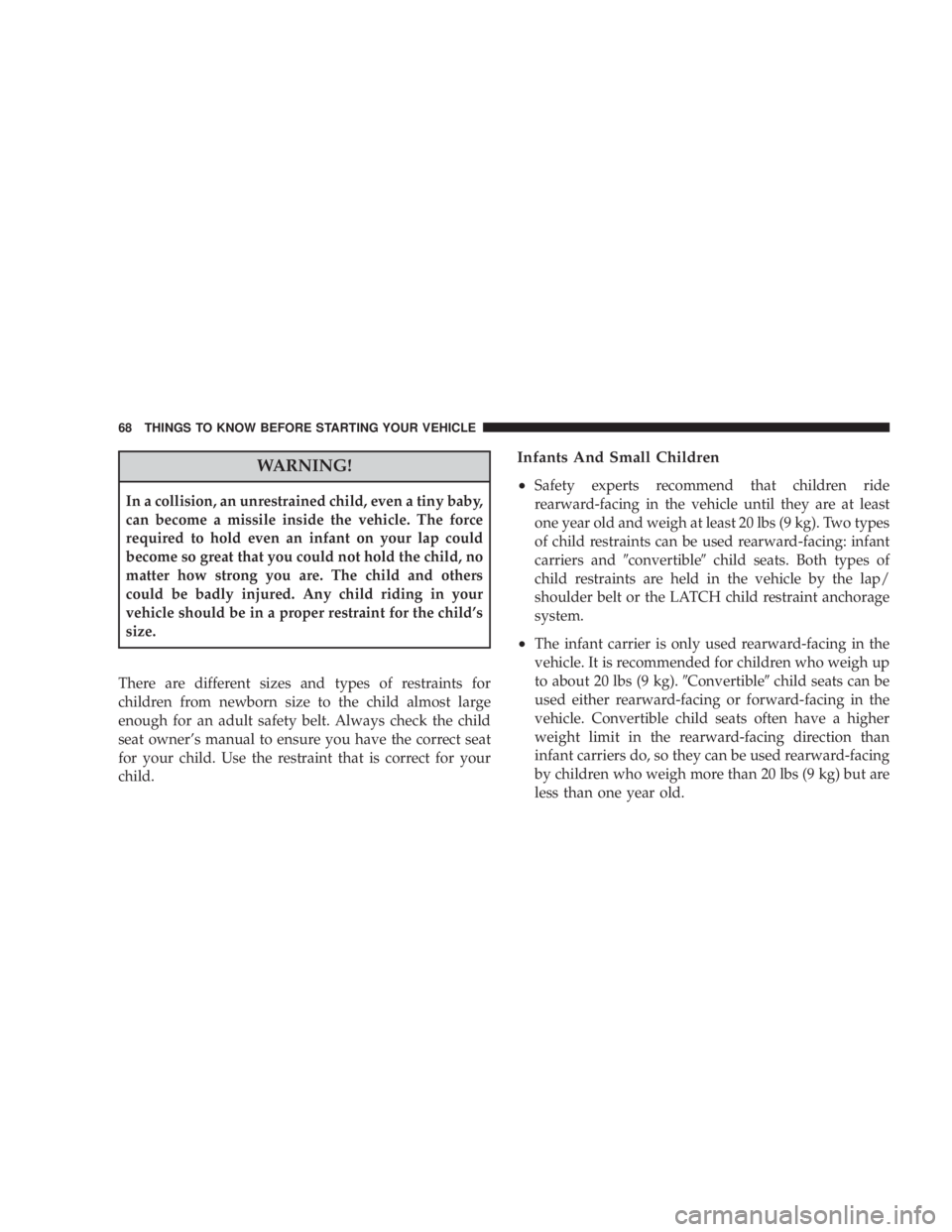
WARNING!In a collision, an unrestrained child, even a tiny baby,
can become a missile inside the vehicle. The force
required to hold even an infant on your lap could
become so great that you could not hold the child, no
matter how strong you are. The child and others
could be badly injured. Any child riding in your
vehicle should be in a proper restraint for the child's
size.
There are different sizes and types of restraints for
children from newborn size to the child almost large
enough for an adult safety belt. Always check the child
seat owner's manual to ensure you have the correct seat
for your child. Use the restraint that is correct for your
child. Infants And Small Children
² Safety experts recommend that children ride
rearward-facing in the vehicle until they are at least
one year old and weigh at least 20 lbs (9 kg). Two types
of child restraints can be used rearward-facing: infant
carriers and 9 convertible 9 child seats. Both types of
child restraints are held in the vehicle by the lap/
shoulder belt or the LATCH child restraint anchorage
system.
² The infant carrier is only used rearward-facing in the
vehicle. It is recommended for children who weigh up
to about 20 lbs (9 kg). 9 Convertible 9 child seats can be
used either rearward-facing or forward-facing in the
vehicle. Convertible child seats often have a higher
weight limit in the rearward-facing direction than
infant carriers do, so they can be used rearward-facing
by children who weigh more than 20 lbs (9 kg) but are
less than one year old.68 THINGS TO KNOW BEFORE STARTING YOUR VEHICLE
Page 71 of 467
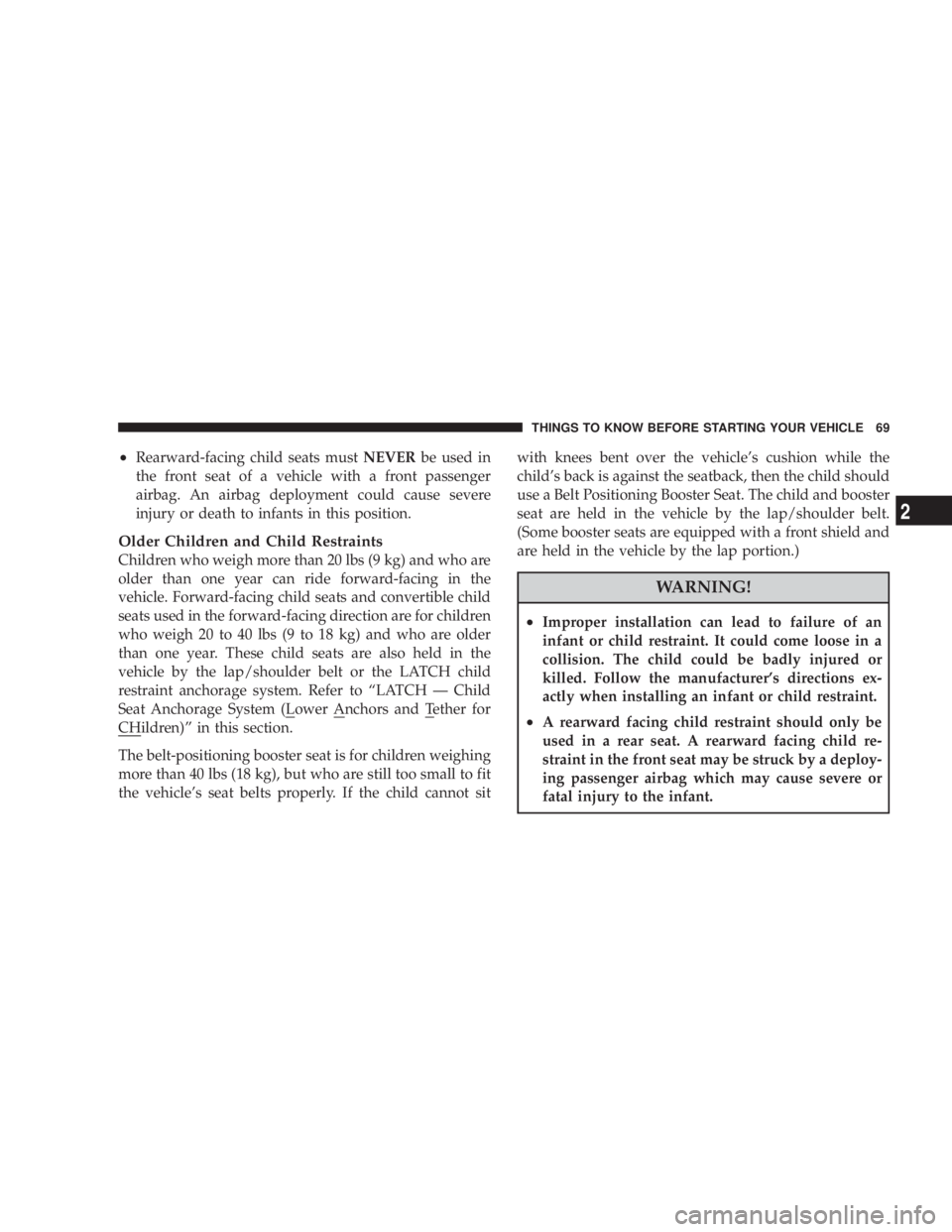
² Rearward-facing child seats must NEVER be used in
the front seat of a vehicle with a front passenger
airbag. An airbag deployment could cause severe
injury or death to infants in this position.
Older Children and Child Restraints
Children who weigh more than 20 lbs (9 kg) and who are
older than one year can ride forward-facing in the
vehicle. Forward-facing child seats and convertible child
seats used in the forward-facing direction are for children
who weigh 20 to 40 lbs (9 to 18 kg) and who are older
than one year. These child seats are also held in the
vehicle by the lap/shoulder belt or the LATCH child
restraint anchorage system. Refer to ªLATCH Ð Child
Seat Anchorage System (Lower Anchors and Tether for
CHildren)º in this section.
The belt-positioning booster seat is for children weighing
more than 40 lbs (18 kg), but who are still too small to fit
the vehicle's seat belts properly. If the child cannot sit with knees bent over the vehicle's cushion while the
child's back is against the seatback, then the child should
use a Belt Positioning Booster Seat. The child and booster
seat are held in the vehicle by the lap/shoulder belt.
(Some booster seats are equipped with a front shield and
are held in the vehicle by the lap portion.)
WARNING!² Improper installation can lead to failure of an
infant or child restraint. It could come loose in a
collision. The child could be badly injured or
killed. Follow the manufacturer's directions ex-
actly when installing an infant or child restraint.
² A rearward facing child restraint should only be
used in a rear seat. A rearward facing child re-
straint in the front seat may be struck by a deploy-
ing passenger airbag which may cause severe or
fatal injury to the infant. THINGS TO KNOW BEFORE STARTING YOUR VEHICLE 69
2
Page 77 of 467

the child restraint belt path and then buckle it. This
should stow the seat belt out of the reach of an
inquisitive child. Remind all children in the vehicle
that the seat belts are not toys and should not be
played with, and never leave your child unattended in
the vehicle.
WARNING!Improper installation of a child restraint to the
LATCH anchorages can lead to failure of an infant or
child restraint. The child could be badly injured or
killed. Follow the manufacturer's directions exactly
when installing an infant or child restraint.
Installing Child Restraint Tether Strap
1. Rotate the cover over the anchor directly behind the
seat where you are placing the child restraint. 2. Route the tether strap to provide the most direct path
for the strap between the anchor and the child seat. If
your vehicle is equipped with adjustable rear head
restraints, raise the head restraint, and where possible,
route the tether strap under the head restraint and 1Ð Cover AÐTether Strap Hook
3Ð Attaching Strap BÐTether AnchorTHINGS TO KNOW BEFORE STARTING YOUR VEHICLE 75
2